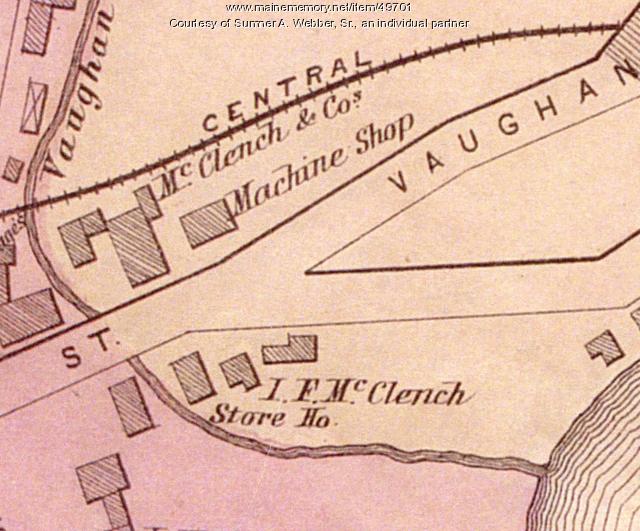Keywords: Lime Industry
- Historical Items (44)
- Tax Records (0)
- Architecture & Landscape (0)
- Online Exhibits (10)
- Site Pages (19)
- My Maine Stories (0)
- Lesson Plans (0)
Site Pages
These sites were created for each contributing partner or as part of collaborative community projects through Maine Memory. Learn about collaborative projects on MMN.
Site Page
Historic Hallowell - Industry at the Mouth of the Vaughan Stream
"The plaster was made of hydrated lime, sand, water, and horse hair. The slate was made of clay or volcanic ash."
Site Page
Thomaston: The Town that Went to Sea - Henry Knox: Lime Works
"… industry in Thomaston.Maine Historical Society Lime was already an active industry in Thomaston by the time Knox moved to the area, and he became…"
Site Page
Western Maine Foothills Region - For The Love Of Paper - Page 3 of 4
"It was to house a new lime kiln, 275 feet in length. This, again, was to save chemicals from the process."
Site Page
"Plaster was a highly sought commodity used to lime farm fields and finish interior walls. The gypsum and grinding stones to supply the mills were…"
Site Page
Islesboro--An Island in Penobscot Bay - Historical Overview
"The Precambrian rocks of 700 Acre, Lime and Lasell Islands are some of the oldest in Maine, dating back over 600 million years."
Site Page
Lubec, Maine - The Lighthouse at West Quoddy Head
"… the hastily built tower soon leaking badly, its lime mortar soft and unsafe. The romanticized image here, derived from an 1837 Maine geology study…"
Site Page
Islesboro--An Island in Penobscot Bay - Early Settlements
"… islands including Seven Hundred Acre, Job’s and Lime were incorporated into one Massachusetts town called Islesborough, Maine being part of…"
Site Page
Islesboro--An Island in Penobscot Bay - Water Transportation
"… first steamboat wharf on Islesboro was built at Lime Kiln in Pripet in 1847. Later, wharves were constructed at Ryder’s Cove, Hewes Point, Smith’s…"
Site Page
Historic Clothing Collection - 1960-1970 - Page 2 of 3
"… from leather but lined in synthetic fabric, and a lime green V neck sleeveless dress with a vest-like six button, double breasted bodice attached…"
Site Page
Thomaston: The Town that Went to Sea - 1870 to 1915
"… Society In addition to shipbuilding, the lime quarry industry- now cement production - continues to be a source of employment in the town."
Site Page
Thomaston: The Town that Went to Sea - Building Boom, early 19th century
"Industries of all types were on the rise – lime quarrying, brickmaking, shipbuilding, export and import shipping, carpentry and trading."
Site Page
View collections, facts, and contact information for this Contributing Partner.
Site Page
Thomaston: The Town that Went to Sea - Thomaston is Incorporated - 1777
"Sloops were built, making regular trips to Boston to transport lime, staves and cordwood, returning with cargoes of flour, bolts of cloth and…"
Site Page
Thomaston: The Town that Went to Sea - Shipbuilding
"Lime kilns were built below the bridge on both sides of the Creek in close proximity to the first shipyards in the area."
Site Page
Historic Clothing Collection - 1960-1970 - Page 3 of 3
"… is square necked, sleeveless and made of a fun lime green very 'sixties' daisy printed fabric. Bridesmaid dress, ca."
Site Page
Cumberland & North Yarmouth - Population Decline in Maine's Coastal Counties
"… impacted to a lesser degree, since a market for lime remained. Sources: Condon, Richard H. “Living in two worlds: Rural Maine in 1930,” Maine…"
Site Page
Thomaston: The Town that Went to Sea - 1940 to Present Day
"… who continue to arrive for work in the boatyards, lime industry or to simply retire, just as many did so many years ago."
Site Page
Historic Clothing Collection - 1970-1980 - Page 3 of 3
"… is made of cotton sateen with a large bold lime, purple, gold and turquoise print design, very similar to those produced by Catherine Ogust for…"
Site Page
Thomaston: The Town that Went to Sea - Early History - 1719 to 1740
"The lime industry soon became a staple of the economy, which continues to this day in the form of Dragon Cement."



















